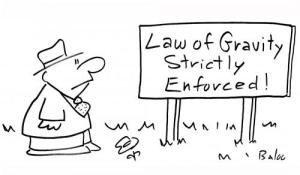Why would the whole of the Universe be a complex, self-organising and interdependent system, and a business be a top-down, controlled machine? Why would the entire Universe be subject to the laws of Nature, and business, not? It’s almost as some businesses they think they exist in some bubble, where the laws of nature are turned away by some bouncer: “You can’t come in here with that gravity. Second Law of Thermodynamics? Not in here, sunny Jim.”
My favourite programmes on telly are the ones about the universe and how it came to be. One I was watching recently had a theme of complexity and order: how order arose out of the chaos of the Big Bang and formed some of the most beautiful sights in our solar system, such as Saturn’s rings. The narrator kept describing the wonders of the solar system as complex and marvelled at how it organised itself over many billions of years, subject to the forces of nature. As I watched, I was making connections to life here on Earth. The point he made in the final minutes of the programme was that we are part of the same complex and wonderful solar system and subject to its same laws. I made the link to organisations, to one client in particular and to one particular phenomenon of systems (you can’t tell a systems thinker to stop being a systems thinker in their free time, sorry). I had a moment of thinking how many who “run” businesses think they are immune from laws of nature, or certainly behave like they do, acting out of old myths like some kind of Flat-Earther.
Complexity, ambiguity, dynamic change and uncertainty are not the new normal; they have been around since the Big Bang. They are part of the fabric of the universe. We have just been (unconsciously) shielding ourselves from the forces of nature by pretending we weren’t a part of it. From the days of lords and serfs to the time we set out on the “scientific management” path, we have applied top-down control mechanisms on people to get them to work, like so many bits of a wind-up clock. Many are finally acknowledging that complexity, ambiguity and so on are part of the fabric of organisational life. Accordingly, we must adjust our ways of doing business to take account of these phenomena of Nature.
Just as, 1000 years ago, we “KNEW” that the Sun went around the Earth, just as we “KNEW” the Earth was flat, just as we “KNEW” that trepanation was a good cure for headaches , many organisations seem to “KNOW” that top-down command-and-control mechanistic structures, with a select few pulling the levers, are the best ways to run things. I believe that if we don’t “unknow” some of the nonsense we still unconsciously adhere to, the forces of Nature will present us with some unpleasant surprises. Even if we continue to “KNOW” that our business is a machine, it does not make it any less true that it is a living system, and thus subject to the laws of living systems.
Entropy
A client who I described in a previous article was reflecting on 2012 recently and observed that they had made some progress in their business over the year. By progress, he meant that
- people were beginning to take up more responsibility and initiative without having to wait for the boss to tell them what to do
- there was more discussion amongst the staff as to how to manage some of the day-to-day challenges they meet and less referring to the boss for the “answer”
- mistakes were being used as entry points to examining business processes and working out how they could be improved
- they had a clearer idea of their collective purpose and how important relationship is to achieving that purpose
- the leaders were devoting more of their time to ensuring the conditions and structures of the business were optimised so that people could get on with their jobs (and less time micro-managing operational tasks).
Thrilling stuff. He also reflected on how shifting the focus away from “behavioural problems” as isolated events and onto the business as a whole living system seemed to have injected some new life (his words, not mine) into the business: that they were actually going somewhere. Here was an example of the practical benefits of applying systems thinking to overcoming business “stuckness”. They started the year stagnating, with things getting worse, they injected some new learning into the system, they are now moving to another level of effectiveness.
Here’s the link to that TV programme and this client’s business: entropy. As a living system, my client’s business is subject to the same laws that pertain to the rest of the universe. One of these is the Second Law of Thermodynamics, a corollary of which is entropy. Entropy, crudely speaking, is the tendency towards death. Social entropy, which applies to organisations, is a “measure of the natural decay of the structure or of the disappearance of distinctions within a social system.” (Krippendorff) As the whole of the universe tends towards randomness, or death, so do all the elements within it. This is not to take a fatalistic approach and say “Why bother doing anything, then?” There are forces that also act to retard entropy. Like with other living systems, some energy needs to go into the pot in order to counteract it. My cup of hot tea will naturally cool down as heat is transferred away from it, but I can re-heat it by applying energy in the from of a microwave oven.
What does entropy look like in the business world?
Kodak.
How do we counteract entropy?
If a business is succumbing to natural entropy and feels like it’s losing track or going nowhere, how can we reheat it? Let’s look to Nature. How do other living systems in Nature counteract entropy? They bring in more stuff. Living systems find loopholes to counteract entropy. In the context of the natural world, this shows itself as adaptation. In the context of business, this means learning. Closed systems that spend their energy simply on maintaining themselves in survival mode eventually spend themselves out. If a business is spending too much of its time on hunting for food, and not enough on learning new ways to hunt for food, it will succumb to entropy. Vibrant and open living systems naturally tend to greater complexity, experiment often, are driven to what is possible and seek new opportunities which destabilise them until they restablise in a renewed way. They look for more stuff to put into the system to renew it.
“Systems thinking is a response to the failure of mechanistic thinking in the attempt to explain social and biological phenomena.” Lars Skyttner
Purpose, not anatomy
If something is not working, look at the bigger picture: purpose, relationships and interconnectedness of the elements. Because entropy (a phenomenon of living systems) is affecting the business, taking a systems thinking approach will be the path to finding its counter-measures. Merely looking at the anatomy of a business is not going to help us solve 21st century problems. As Skytnner writes, the emergence of a holistic approach came about in an effort to provide us “an outlook to see better, a network to understand better and a platform to act better.” This is something that is dear to my heart. Systems thinking gives us a real-life, practical way to actually craft the way we do things better and more effectively, not simply some intellectual exercise that sounds lovely.
Systems thinking is not a prescription or method, it’s more of a perspective or way of approaching problems. Systems thinking can help us to look for patterns within businesses, to see fundamental structures and their impact on the elements (the people, the departments, the sub-groups) within the business as well as on the relationships between those elements.
When living systems, such as a business, get to a certain point, they begin to entropy. Unless something new is added to the system, it will tend towards death. If we continue to apply the same-old, same-old solutions to address this problem, we are not bringing anything new into the system. “Something new” requires learning. Learn what is working well. Learn what is not working well. Learn where the connections are within the business. Learn where the disconnects are. Learn from the customer.
A business will not have sustainable life unless it is infused with energy from outside itself. For a business to operate as a closed system, starving itself of innovation and creativity of its own people or ignorant of its customers and environment, entropy takes over. It will tend towards death. A “she’ll be right”, “it’ll sort itself out” attitude will lead to greater mess, greater randomness, and without new energy in the system to help deal with the mess, it will die away. Things do not sort themselves out. If I don’t maintain my house, it’ll eventually crumble over time. This is a real example of how the Second Law of Thermodynamics affects us. A hot cup of coffee will tend, over time, to lose heat. A living system starved of nourishment will eventually cease to exist. A business led by managers who see their role as nothing more than “competent supervision” will tend towards disintegration and eventually have a “Kodak moment” (not the picturesque kind). To be successful, a business must adapt to its ever-changing environment and to its own ever-changing internal dynamics that emerge out of the interactions between all the elements within in. A successful business must gain nourishment from outside its steady state: from innovation and creativity, from market information, from ongoing learning. When a business applies systems thinking, it can find new ways to renew itself.
Businesses that will do well in this networked age will overcome the natural phenomenon of entropy by becoming open to what could be and taking steps to do something different. They will learn to think bigger. They will see learning and renewal of their business processes as part of their new culture of continuous improvement. They will see the business as a living system and not a machine. They will see mistakes as opportunities for learning and renewal, rather than through the old lens as a “disciplinary issue”.
When Harold Jarche says work is learning and learning is the work, I think he’s suggesting that for a business to thrive, it must place learning at the heart of everything it does. Purposeful learning. Learning that is not “training” as we have visioned it up till now. Any training that is disconnected from the people is not sufficient. Learning that is not about the work is not sufficient. Real 21st century learning must change how we think, behave and interact with each other, as well as what we know. It must be relevant to purpose, activity and relationships. Not just one of those: all three. A business, which is a living system, requires relevant learning in order to subvert that thing which happens to all living systems: entropy.





